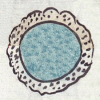Atecochtli Ehecatl Nequetzayan (CQ)
This compound glyph for the toponym or place name Atecochtli Ehecatl Nequetzayan has two principal features. One is a body of water, perhaps a watering hole (from a, atl, water, and tecochtli, hole, pit, grave). The circular body of water is shown from a bird's eye view. It has wavy black lines that may suggest waves. The edge of the circle is scalloped. The other prominent feature to this compound is what appears to be a bird's head in profile, looking to the viewer's right. The head is a gray-brown, with a white open eye. The beak (or what some sources describe as a duck bill) is complex, with a white/natural protrusion and a red one on top of the upper (curved) beak. The divine force of the wind, Ehecatl, was believed to have a device in his mouth for blowing wind. The bird's mouth is open, and what appear to be three curling speech scrolls (wind?) emerge. These are natural, without colorants.
Stephanie Wood
The bird-like head seems to represent the divine force of wind, Ehecatl (also a day sign in the calendar). That the gloss only says Ecatl (without the reduplication of the first syllable) is not unusual for this sign. Ecatl means breath/air, and the reduplicated form means wind. The scrolls coming out of the beak seem to indicate this air movement. Compare this Ehecatl to others in this collection (below).
This compound glyph could be seen as a phrase, but it could also be a sentence: "[This is] the watering hole where Ehecatl customarily stands," or "[This is] the watering hole where the wind customarily blows." The verb to be is often implied in Nahuatl.
This watering hole has a visual appearance something like the amanalli that we include in this collection from the Map of Cempoala (see below).
The -yan locative ending, according to Frances Karttunen (unpublished manuscript about the Codex Mendoza glyphs) says that the preceding verb (in this case quetza, to stand) is habitually or customarily done in this location. Thus, this watering hole is where Ehecatl customarily stands. In other words, perhaps, it is a pond where the wind always blows?
Stephanie Wood
atecochtli Ecatl
nequetzaya
Atecochtli Ecatl (or Ehecatl) Nequetzayan
Stephanie Wood
covers ruling men and women of Tecamachalco through 1593
Stephanie Wood
winds, air, breath, vientos, aliento, aires, deities, deidades, divinities, divinidades, nombres de lugares

a(tl), water, https://nahuatl.wired-humanities.org/content/atl
tecoch(tli), hole, pit, grave, https://nahuatl.wired-humanities.org/content/tecochtli
eca(tl), breath or air, https://nahuatl.wired-humanities.org/content/ecatl
eheca(tl), wind or wind deity, https://nahuatl.wired-humanities.org/content/ehecatl
quetza, to stand, https://nahuatl.wired-humanities.org/content/quetza
-yan (locative suffix), where the action of the preceding verb customarily happens, https://nahuatl.wired-humanities.org/content/yan
Atecochtli Ecatl Nequetzaya “The Pool Where the Wind Rises” [depicting the wind god’s bird mask]. Matthew T. McDavitt, “Placenames in the Codex Quetzalecatzin,” unpublished essay shared 2-21-2018.
El estanque de agua donde Ehecatl normalmente se para, o donde siempre hay viento
Ofelia Cruz Morales y Stephanie Wood
The Codex Quetzalecatzin, aka Mapa de Ecatepec-Huitziltepec, Codex Ehecatepec-Huitziltepec, or Charles Ratton Codex. Library of Congress. https://www.loc.gov/item/2017590521/
The Library of Congress, current custodian of this pictorial Mexican manuscript, hosts a digital version on line. It is not copyright protected.








